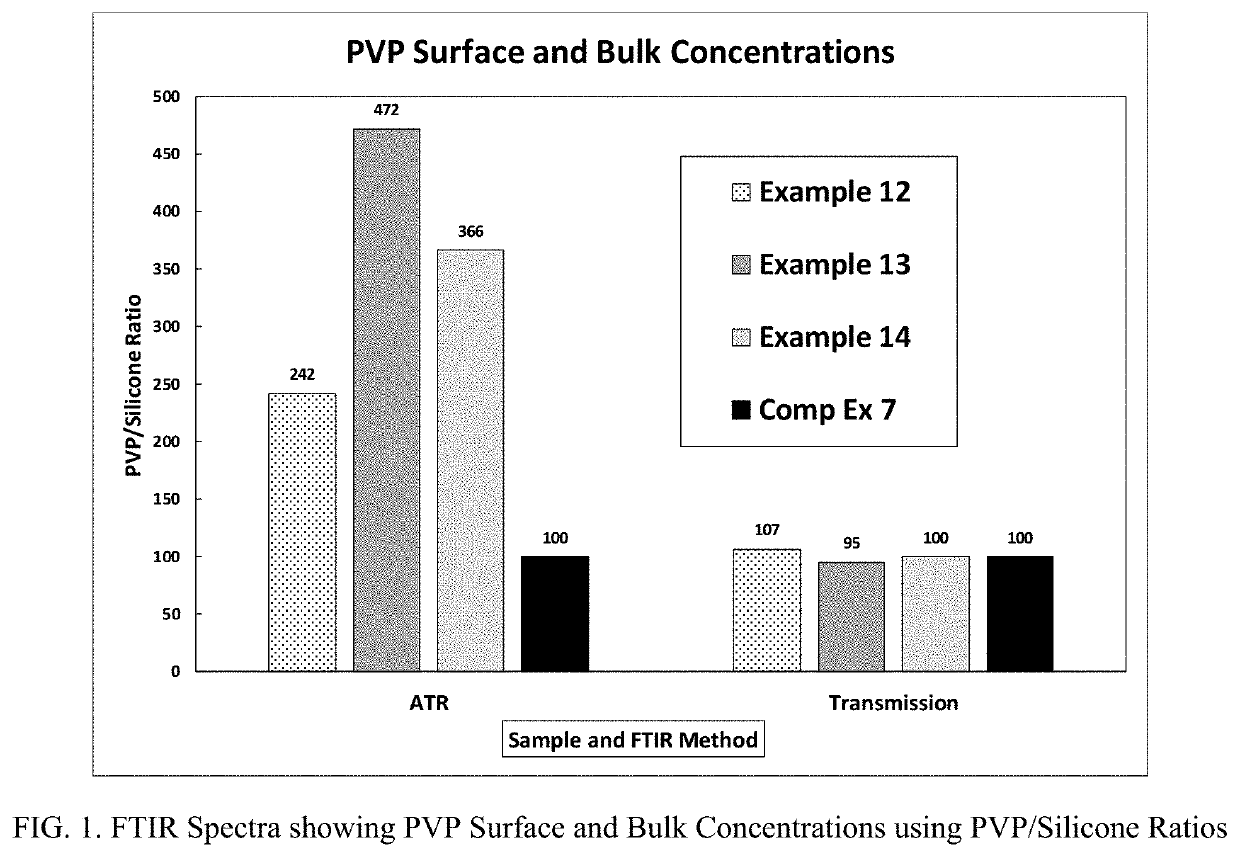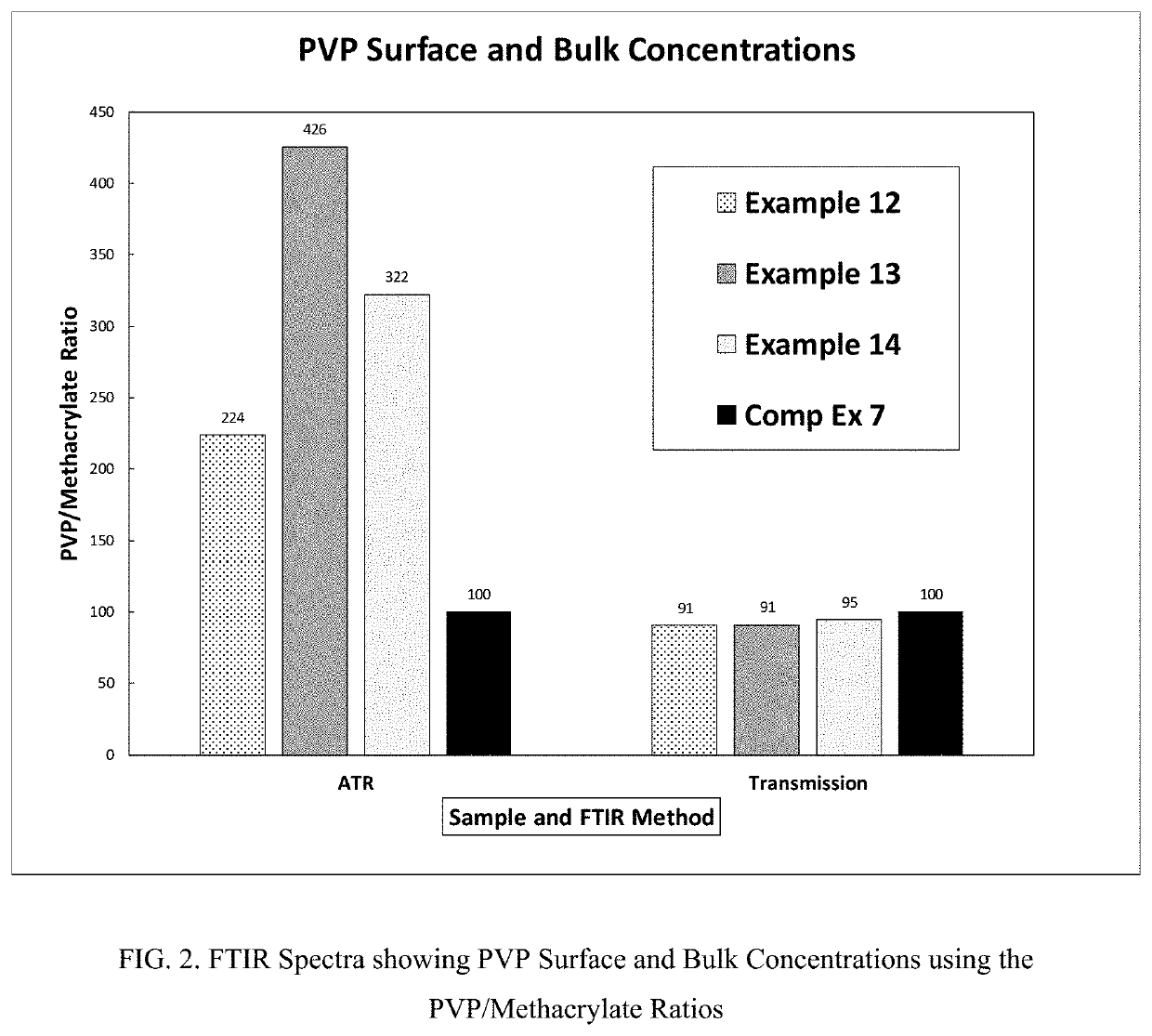Silicone hydrogel contact lenses having non-uniform morphology
a technology of hydrogel contact lenses and silicone hydrogels, which is applied in the field of silicone hydrogel contact lenses having non-uniform morphology, can solve the problems of reducing the compatibility of these lenses with the eye, adding complexity and cost, and reducing visual acuity when using these lenses, so as to achieve the same wettability, improve surface wettability, and more efficient
- Summary
- Abstract
- Description
- Claims
- Application Information
AI Technical Summary
Benefits of technology
Problems solved by technology
Method used
Image
Examples
examples
[0161]The contact lens diameter (DM) was measured on a calibrated Van Keuren micro optical comparator equipment equipped with Mitutoyo digimatic micrometer heads. The contact lens was placed concave side down into a crystal cell completely filled with borate buffered packing solution. A cap was placed onto the cell ensuring that no air is trapped underneath. The cell was then placed on the comparator stage and the lens image brought into focus and aligned so that one edge of the lens touched the center line on the screen. The first edge was marked, the lens moved along its diameter until the second edge is touching the center line on the screen, and then, the second edge is marked by pushing the data button again. Typically, two diameter measurements are made and the average reported in the data tables.
[0162]Water content (WC) was measured gravimetrically. Lenses were equilibrated in packing solution for 24 hours. Each of three test lenses is removed from packing solution using a sp...
examples 1-9
[0222]Reactive monomer mixtures were prepared composed of 77 weight percent of the formulations listed in Table 1, and 23 weight percent of the diluent D3O. The reactive monomer mixtures were individually filtered through a 3 μm filter using a stainless-steel syringe. Then, at the time of use, about 0.074 grams of AIBN (thermal initiator) were dissolved in 20.0000 grams of RMM. The weight percent of AIBN was about 0.37 weight percent in the final RMM.
[0223]The RMMs with AIBN were degassed at ambient temperature by applying vacuum (40 torr) for at least 20 minutes. Then, in a glove box with a nitrogen gas atmosphere and less than about 0.2 percent oxygen gas, about 75-80 μL of the reactive mixture were dosed using an Eppendorf pipet at room temperature into the FC made of Zeonor. The BC made of 55:45 (w / w) Z:PP blend was then placed onto the FC. The molds were equilibrated for a minimum of twelve hours in the glove box prior to dosing. About 20 pallets each containing eight mold asse...
examples 8-11
[0236]Reactive monomer mixtures were prepared composed of 77 weight percent of the formulations listed in Table 5, and 23 weight percent of the diluent D3O. PVMA from Preparation 1 was used. The reactive monomer mixtures were individually filtered through a 3 μm filter using a stainless-steel syringe. Then, at the time of use, about 0.037 grams of AIBN (thermal initiator) were dissolved in 10.0000 grams of RMM. The weight percent of AIBN was about 0.37 weight percent in the final RMM.
[0237]The RMM with AIBN were degassed at ambient temperature by applying vacuum (40 torr) for at least 20 minutes. Then, in a glove box with a nitrogen gas atmosphere and less than about 0.2 percent oxygen gas, about 70-75 μL of the reactive mixture were dosed using an Eppendorf pipet at room temperature into the FC made of Zeonor. The BC made of 55:45 (w / w) Z:PP blend was then placed onto the FC. The molds were equilibrated for a minimum of twelve hours in the glove box prior to dosing. About 20 pallet...
PUM
| Property | Measurement | Unit |
|---|---|---|
| contact angle | aaaaa | aaaaa |
| contact angle | aaaaa | aaaaa |
| weight percent | aaaaa | aaaaa |
Abstract
Description
Claims
Application Information
 Login to View More
Login to View More - R&D
- Intellectual Property
- Life Sciences
- Materials
- Tech Scout
- Unparalleled Data Quality
- Higher Quality Content
- 60% Fewer Hallucinations
Browse by: Latest US Patents, China's latest patents, Technical Efficacy Thesaurus, Application Domain, Technology Topic, Popular Technical Reports.
© 2025 PatSnap. All rights reserved.Legal|Privacy policy|Modern Slavery Act Transparency Statement|Sitemap|About US| Contact US: help@patsnap.com



